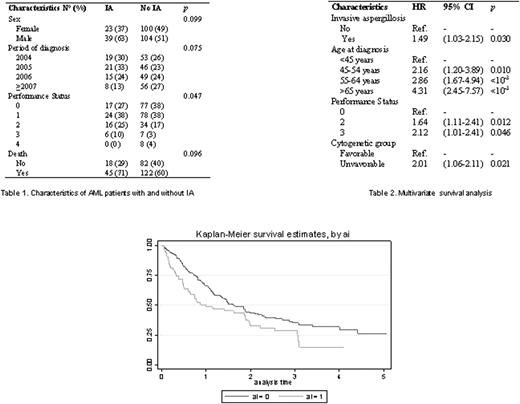Abstract
Abstract 1010
Poster Board I-32
Invasive aspergillosis remains an important cause of death for AML patients. Recently a lot of efficient innovative agents have been proposed as curative, empiric and more recently prophylaxis therapy in the IFI setting. It has been demonstrated that some agents used either as early treatment or prophylaxis of IFI had a significant impact on early survival (Day 100) of AML patients. The principal aim of our study was to see if this observation was true when considering a long-term period and how the development of an IA during the AML story interferes on the therapeutic strategy and finally on the long-term survival. We decided to conduct a study in our centre from 2004 to 2009 on a cohort of AML patients and to compare patients who developed an IA with patients who never developed in IA during the period of observation. Chi2 test and Fischer exact test were used for the comparison of discrete variables, U Mann-Withney test for continuous variables, survival analysis used Kaplan-Meyer and Cox proportional hazard model. We studied a total of 267 patients which represented 151 716 patient-days at risk (415 patient-years) and the longer follow-up was 5.1 years. Sixty-three patients developed an IA: 7 (11%) proven, 24 (38%) probable and 32 (51%) possible. The median delay between chemotherapy induction and IA was 22 days (IQR 16-29). The characteristics of the population were 123 females and 144 males (54%) with a median age of 56.7 years (47.9-64.9). The performance status (PS) 0 (n=94/35%), 1 (n=102/38%), 2 (n=50/19%), 3 (n=13/5%), 4 (n=8/3%), FAB classification 0 (n=17/6%), 1 (n=45/17%), 2 (n=42/16%), 3 (n=20/8%), 4 (n=28/10%), 5 (n=68/26%), 6 (n=8/3%), 7 (n=14/5%) (25 patients were not classified) and the cytogenetics were favourable (n=26/10%), intermediate (n=98/38%) and unfavourable (n=111/42%) (26 patients were not classified). As induction treatment patients received standard chemotherapy (n=180/67%), intensive regimen (n=86/32%) and 1 patient (1%) received low dose chemotherapy. At the last follow-up 115 patients have relapsed (43%), 100 are alive and 167 died. All characteristics below were compared between patients with and without IA during their disease course and 4 variables were significantly different (Table 1).The probability of overall survival was at the end of induction (D 30): 95% (86-98) with IA and 98% (95-99) without IA, at day 100: 79% (67-87) with IA and 92% (88-96) without IA, at 1 year 49% (36-60) with IA and 66% (60-73) without IA, at 2 years 33% (21-46) with IA and 43% (37-51) without IA and at 4 years 15% (5-30) with IA and 32% (24-40) without IA(Figure 1). The median survival time was 1.51 years (95%CI 1.19-1.88) with 1 year (95%CI 0.60-1.89) with IA and 1.62 years (95%CI 1.33-2.18) without IA. The univariate analysis on OS showed a significant influence of IA (p=0.028), age (p<0.001), cytogenetics (p<0.001), chemotherapy (better survival for intensive therapy compared to standard p<0.001) and a trend for period of diagnosis (better survival in ≥2007 vs before 2007: p=0.08). The multivariate analysis showed a significant impact on OS of IA, age, PS and cytogenetics (Table 2).In conclusion, IA appears as a significant risk factor besides age, PS, cytogenetics either on short or on long-term survival in AML. Differences of IA incidence observed over time may be related to prophylaxis strategy (environment, antifungal prophylaxis) applied during different periods. These results point out the importance of antifungal prophylaxis for fit AML patients
No relevant conflicts of interest to declare.
Author notes
Asterisk with author names denotes non-ASH members.


This feature is available to Subscribers Only
Sign In or Create an Account Close Modal